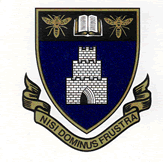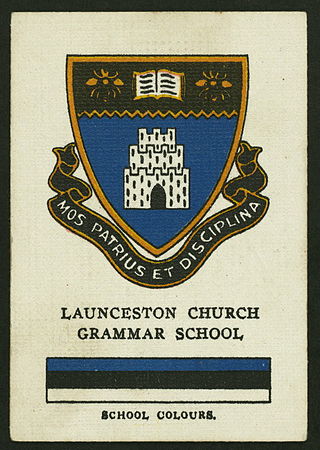Loading AI tools
School in Launceston, Tasmania, Australia From Wikipedia, the free encyclopedia
Launceston Church Grammar School (informally Launceston Grammar or simply Grammar, commonly abbreviated to LCGS) is an Anglican co-educational private school in Launceston, Tasmania, Australia for Early Learning through to Grade 12.
| Launceston Church Grammar School | |
|---|---|
 | |
| Location | |
 | |
| , Australia | |
| Coordinates | 41°24′29″S 147°7′39″E |
| Information | |
| Type | Independent, co-educational, day & boarding |
| Motto | Latin: Nisi Dominus Frustra (Unless the Lord is with us, our labour is in vain) |
| Denomination | Anglican |
| Established | 1846 |
| Chairman | Nigel Bailey |
| Principal | Dale Bennett |
| Chaplain | Matthew Pickering |
| Staff | 155[1] |
| Enrolment | 838 (PK–12)[2] |
| Colour(s) | Blue, black & white |
| Slogan | Nurture, Challenge, Inspire |
| Affiliation | Sports Association of Tasmanian Independent Schools |
| Website | www |
Although founded in 1846, the present school was formed in 1936 from the amalgamation of the boys' Launceston Grammar School and girls' Broadland House Church of England Girls' Grammar School. The school celebrated its 175th birthday on the 15th of June 2021 and retains its longevity, being the longest continuously running independent school in Australia and Tasmania, and being the oldest form of private secondary education in Tasmania. The school is also the second-oldest form of education in Tasmania, after Christ College, Tasmania, the oldest form of education in Australia, now used as a residential college of the University of Tasmania.
Launceston Grammar is affiliated with Association of Heads of Independent Schools of Australia (AHISA), the Independent Primary School Heads of Australia (IPSHA), the Australian Boarding Schools' Association (ABSA), and the Sports Association of Tasmanian Independent Schools (SATIS).
The school competes mainly with Scotch Oakburn College and St Patrick's College, Launceston for student numbers, the three being the only large-scale private schools in Launceston.
The school is widely regarded as one of Australia's most prestigious schools: from 2001 to 2004 The Australian listed Launceston Church Grammar School among the top ten schools in the country, and in 2010 The Age reported that Launceston Grammar ranked equal tenth among Australian schools based on the number of alumni who had received a top Order of Australia honour.[3]

This section needs additional citations for verification. (May 2023) |
On 15 June 1846, the school was founded and Henry Plow Kane was chosen as its founding headmaster. The school began in temporary premises on the North-East corner of George and Elizabeth Streets, but soon after commenced building on the site immediately behind St John's Church. And so began an enduring and close relationship between St John's Church and the Launceston Church Grammar School.
On the day after Grammar opened its doors, 24 boys of varying ages were enrolled and Launceston was described as "a small town with a population of about 8000 people and the town was little more than a scattered village." In 1848 the visitor, the first Anglican Bishop of Tasmania, Francis Russell Nixon, came to the school and a soiree was held in his honour. The current bishop of Tasmania continues this tradition as the visitor and comes annually to the school.
In 1884 the new headmaster was Arthur Hammerton Champion. He had just married Mary the sister of Annie Jane Duncan who would become a factory inspector in Britain and Australia,[4]
An independent school known as Launceston High School existed from 1884 until 1912. It was founded by Edward Alleyne Nathan, who had been a teacher at Launceston Church Grammar School. This school was established at Milton Hall in Frederick Street, Launceston. Nathan remained as headmaster of the school until 1899, when he was succeeded by R. Ernest Smith. Launceston High School eventually merged with Launceston Church Grammar School.[5] The alumni of both schools held joint reunions as the Old Launcestonians' Association after the schools merger.[6]
In 1896, Launceston Church Grammar School celebrated its 50th year under the headmasters the Revd Christopher Wilkinson and Mr Harry Gillett with a jubilee service at St John's and a grand ceremony in the Albert Hall. By 1920 the school had outgrown its site, and in 1924 its ninth headmaster, John Bethune, presided over the only major move in the school's history when it went from Elizabeth Street to a new 25-acre site on Stephenson's Farm in Mowbray – purchased for 2,000 pounds.
The school community suffered deeply during the war years as students served their country, many making the ultimate sacrifice. Headmaster, Captain Norman Roff was amongst those killed in World War II action. The next major milestone for the school was its centenary in 1946 under Headmaster Harold Vernon Jones. Although the school by now had built its own chapel, history records that "the final Centenary celebration was a church service held in the original church which School members attended, and two hundred present scholars and two hundred and fifty Old Boys lined up outside the old School in Elizabeth Street and marched to St John's Church, as Grammar boys had done for so many years." This was an emotional occasion for many Old Boys as they relived their youth, and the bishop gave an inspiring address to the congregation of a thousand, telling them they must develop international fellowship.
The past 50 years have brought further major milestones for the school. One was the move to co-education in 1972. Although 100 years before, in 1872, two girls Edith Savigny and Mary Archer both attended Grammar for several years. In 1899, the enrolment was recorded as 150 boys and one girl – Joyce Wilkinson. In 1921, Charlie Irvine, daughter of the Matron, Mrs Irvine, also attended the school. In 1983 Grammar amalgamated with the Broadland House Church of England Girls' Grammar School. Broadland House itself beginning in the 1840s. Broadland House is honoured with a memorial window in St John's Church.
| Period | Details[7] |
|---|---|
| 1846–1860 | Rev H. P. Kane |
| 1860–1863 | Rev F. W. Quilter |
| 1864–1871 | Rev W. A. Brooke |
| 1872–1885 | Rev W. H. Savigny |
| 1885–1895 | Rev A. H. Champion |
| 1895–1915 | Mr R. H. Gillett |
| 1915–1917 | Rev F. Shann |
| 1895–1918 | Rev C. G. Wilkinson |
| 1919–1928 | Rev J. W. Bethune |
| 1929–1935 | Mr F. R. Adams |
| 1936–1940 | Capt. N. H. Roff |
| 1940–1952 | Mr H. V. Jones |
| 1953–1958 | Mr B. H. Travers |
| 1959–1971 | Mr D. V. Selth |
| 1971–1978 | Mr R. P. Hutchings |
| 1979–1980 | Mr J. B. Windeyer |
| 1981–1993 | Mr C. S. Strong |
| 1994–2002 | Mr P. A. B. Welch |
| 2003–2017 | Mr R. S. J. Norris |
| 2018–2022 | Mr R. C. Ford |
| 2022–2022 (acting) | Mr N. Foster |
| 2023 - | Mr D. A. Bennett |
The Senior Campus is located in the suburb of Mowbray Heights, Launceston and caters for students in Grades 7 – 12. This site includes the School Chapel, Poimena Art Gallery, School Hall, Gymnasium, Boarding House and Swimming Pool. The chapel is a popular location for weddings.
The Junior Campus is located at the old Broadland House site on the corner of Lyttleton Street and Elphin Road, East Launceston. The campus was redeveloped in 2010.
At the beginning of 1924, Launceston Grammar moved to the campus at Mowbray Heights. With new quarters, the house system was inaugurated by the headmaster, the Revd John Bethune. Four houses were created and named in honour of the Revd William Savigny, the Revd Christopher Wilkinson and Mr Harry Gillett, former headmasters; and Mr William Hawkes, a generous benefactor. In 1959, an additional day house was formed and named in honour of former headmaster, Mr Norman Roff. The large number of boarders at the Senior School in 1961 made it necessary to introduce another house for purposes of administration. This was Fraser House and was named in honour of the late Mr Hugh Fraser MBE, who had been actively associated with the school for fifty-six years. Fraser House ceased operation in 1970 until 1997. In 1998, under headmaster Mr. Peter Welch, the boarding house was renamed Hawkes House and two new day houses were created; Fraser House and Savigny House. In 2001 Hawkes House discontinued as an entity for house competition and the boarders were reallocated across the five other houses. The name Hawkes is retained as the name of the boarding house.
Launceston Church Grammar School is a member of the Sports Association of Tasmanian Independent Schools (SATIS).
Launceston Church Grammar School has won the following SATIS premierships.[8]
Combined:
Boys:
Girls:
One of the Launceston Church Grammar School's aims is to provide a globally relevant education. As such, the school is home to many international students, and has formed international links with countries including:
Several exchanges also take place during the year, to countries including England, the United States, Germany and Japan. The school is, in turn, visited each year by three international schools, six mainland schools, and four other Tasmanian schools.
The school's past and present sister and brother schools include Hutchins School, St Michael's Collegiate School, Geelong Grammar School, Melbourne Grammar School, Charterhouse School, Eton College, Harrow School, Rugby School, St Paul's School, Sherborne School for Girls, Shrewsbury School, Westminster Abbey Choir School, Winchester College, Osaka International School and The Barstow School.[9]
Alumni of the Launceston Church Grammar School (and its predecessors) are known as Old Launcestonians. All students who have attended Launceston Grammar automatically become members of the Old Launcestonians' Association (OLA), the organisation which represents former scholars of the school. Grade 12 valedicts are awarded life membership of the OLA, and honorary membership is bestowed upon all staff members who serve 10 years or more.[10]
Seamless Wikipedia browsing. On steroids.
Every time you click a link to Wikipedia, Wiktionary or Wikiquote in your browser's search results, it will show the modern Wikiwand interface.
Wikiwand extension is a five stars, simple, with minimum permission required to keep your browsing private, safe and transparent.